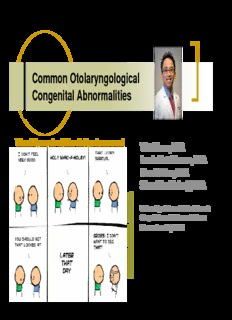
Congenital Abnormalities PDF
Preview Congenital Abnormalities
Common Otolaryngological Congenital Abnormalities Visual Synopsis of Classic Syndromes and Viet Pham, M.D. Features Lewis Hutchinson, M.D. Harold Pine, M.D. Shraddha Mukerji, M.D. s c mi o University of Texas Medical Branch c / et Grand Rounds Presentations n . m November 22, 2010 s o pl x e . w w w / / : p t t h Foreword and Acknowledgements Special appreciation to Dr. Hutchinson for his assistance and contribution Additional gratitude to Drs. Pine and Mukerji All clinical photos are presented solely for educational purposes All other photos were obtained via a Google search unless otherwise specified and are used without http://www.explosm.net/comics permission Objective Highlight typical features of congenital abnormalities evaluated in the otolaryngology practice Visual emphasis on classical presentation of commonly encountered syndromes Down Syndrome (Trisomy 21) Extra chromosome 21 Meiotic nondisjunction in gamete formation Mosaicism (1-2%) Robertsonian translocation (2-3%) Duplication (rare) Increased risk with advanced maternal age Most common cause of intellectual disability Down Syndrome Features Brachycephaly Flat nasal bridge and occiput Small, low-set ears Macroglossia, glossoptosis Upslanting palpebral fissures Epicanthal folds Brushfield spots Simian crease Sandal gap deformity of feet Excessive nuchal folds Mental retardation (courtesy of Dr. Hutchinson via Maria Blazo, M.D.) Down Syndrome Features Brachycephaly ) 9 0 0 2 , v e h s mi r u o Upslanting palpebral fissure D ( ) 9 0 0 Macroglossia, 2 v, Epicanthus glossoptosis e h Flat nasal bridge, s mi r hypoplastic maxilla u o D Microtic, low-set ears ( ) 9 0 0 2 , v e h s mi r u o D ( Excessive Brushfield spots Sandal deformity Simian crease nuchal folds Down Syndrome Other Features Muscular hypotonia Strabismus Congenital cataracts Atrial or ventricular septal defect Gastroesophageal reflux Duodenal stenosis or atresia Hirschsprung disease or celiac disease Seizures Down Syndrome Prenatal Ultrasound Absent nasal bones First trimester (60-80%) Second trimester (37-41%) Hypoplastic nasal bones Not useful as single marker in first trimester Best used with absent nasal bones in second trimester (60-100%) (Gonçalves, 2004) Down Syndrome Otolaryngological Considerations Tympanostomy tubes Esophageal atresia, tracheoesophageal fistula Atlantoaxial instability Obstructive sleep apnea Hypothyroidism Increased risk for malignancy Acute lymphoblastic leukemia Transient myeloproliferative disorder Crouzon Syndrome (Craniofacial Dysostosis) Autosomal dominant Virtually complete penetrance Mutation of fibroblast growth factor receptor II (FGFR2) on chromosome 10 Affects first pharyngeal arch Precursor maxilla and mandible Early fusion of face and skull bones (courtesy of Dr. Pine)
Description: